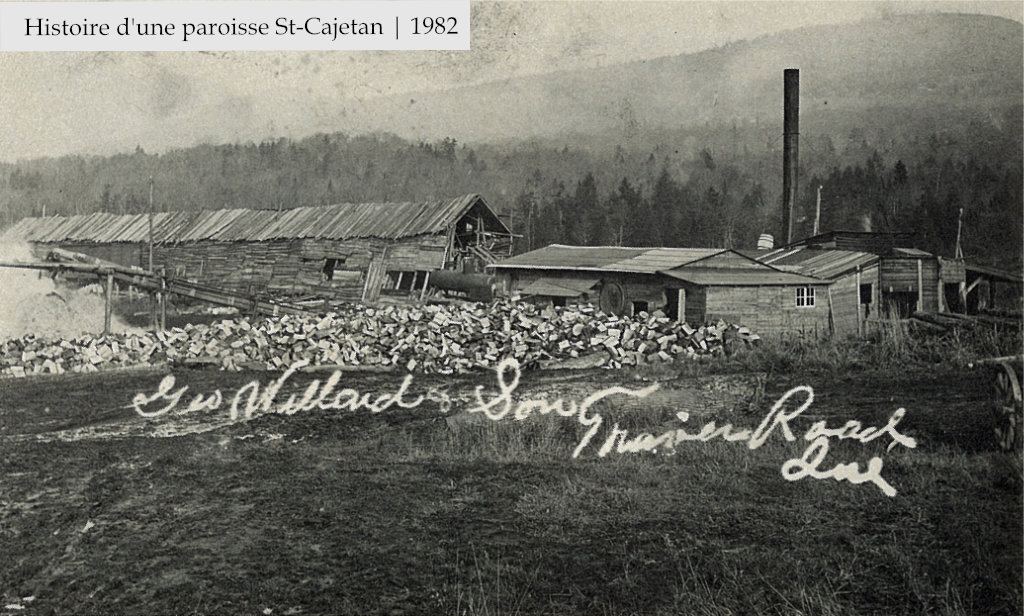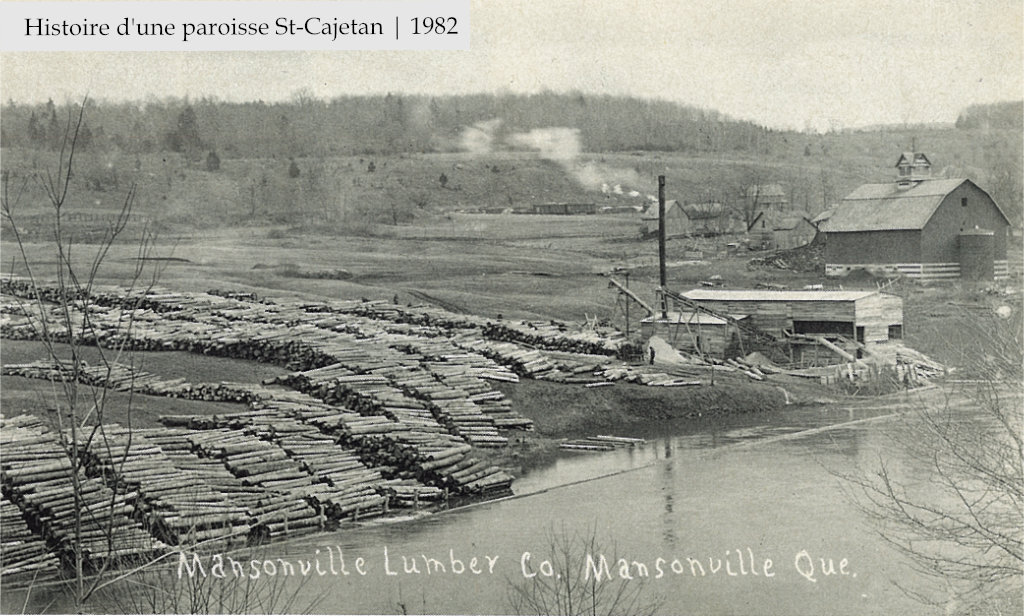Lumbering
Very easy to imagine our ancestor's struggle for life, easy also to imagine (because there were no photographs) them making a path in the dense forests for their oxen and the cart and themselves. What was sweating for some, was the source of industry for others. All were lumbering.
The first saw mill was built in 1800, by Colonel Henry Ruiter, on the Ruiter Brook. Where Mansonville is now, Joseph Chandler built a saw in 1803. Around 1825, Robert Manson continued to promote the prosperity of the Village by the erection of mills.
Through a very rudimentary way, logs are piled, carried to the saw mills, here and there, then eut in the· required length, planed and stacked, ready for different uses, but what a relief for man compared to using the axe. As shown by the photo of 2,000,000 ft. of logs, it seems that saw mills were a good industry.
Since about 1890, and for many years, it was very alive and busy, not to say noisy around Upper and Lower Dams in Mansonville Village.
First, on East side, Claude Boright operates a saw mill somewhere behind Athletic Club Field (Photo). At the same time Charles Brouillette and his two sons, Albert, and Paul, own a saw mill and in 1904, above the center of the upper Dam, they also built an "Electric Mill" (refer to Brouillette's page). Still, on East side of Missisquoi River, Volney Atwell (father of Marion) owns a saw mill, on the Lower Dam, where furnace and stove wood is eut from logs.
Second, on west side, about 1895, where the Coop now stands, Henry Boright has a wood shop on upper Dam and Workers would make butter containers "tinettes de beurre". ln 1925 he builds a grist mill, a few yards lower, on Lower Dam. A few years later, Arthur Leduc purchases the first mill from Henry Boright, discontinues the "tinettes" and competes with Boright in grist mill business. ln 1927 flood, the west side mills resist on account of their concrete pillars. lt is still the same building (renovated) where the Coop stands.
ln 1923, Monticello Bobbin Mill was built, south west of Mansonville Village, just as Jean-Charles Labranche's Bobbin Mill in South Bolton, and Patton valley Bobbin Mill, owned by Philias (Chick) Hamelin since 1975. In these mills, chunks are steamed, split, planed and turned and sanded in order to wind thread in textile factories.
The St-Jacques, operate Mansonville Lumber since 1939 and the Champigny's saw mill opened in 1972. The Georges's for many years had a mill on Baker Talc road.We can still see the foundations of Claude Boright's.
About 1907, Georges Willard built the first Last Black Mill at McNeil's Crossing, where the Orford Mountain Railroad crossed the Traver Road. lt employed between 20 and 30 men, lumbering in the winter, working in the mill during the spring and summer, and loading the dried blacks in box cars to be shipped via the O.M.R. to Miner Rubber Company, Granby, and overseas to England; for many years this operated.
World War 1, stopped the overseas shipments, but a new outlet was found: Lynn, Massachusetts, via North Troy, VT. After the death of Mr. Willard in 1926, and of his son in 1928, the business was no longer carried on.
Many of you remember the small island, just upstream of the actual bridge on Bridge Street, in Mansonville, logs would remain there to dry, before being eut, planed and so on, at Paul Brouillette's Mill. The 1927 flood washed the whole thing away.
Billy Coons saw mill, in Leadville about 1895. lt has operated for at least fourty years. lt was located where Henry Everett still lives, on Leadville Road. Henry worked for Billy Coons during 26 years; then he changed for another Coons mill, which became Monticello Bobbin Mill, built in 1923, starting as a general saw mill, andturned into Block Mill in 1928. ln 1932, Fred Perkins purchased this last one and they would make bobins during winter and eut and saw soft wood during summer. Georges Hamelin worked then from 1932 to 1942. lt was sold to Monticello in 1945 and the Bobbin's business kept on going up to 1976, when it was auctioned and took down into pieces.


